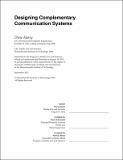Designing complementary communication systems
Author(s)
Harry, Drew
DownloadFull printable version (45.03Mb)
Other Contributors
Massachusetts Institute of Technology. Dept. of Architecture. Program in Media Arts and Sciences.
Advisor
Chris Schmandt.
Terms of use
Metadata
Show full item recordAbstract
We have long assumed that being face to face is the best environment for social interaction. But is "being there" the best we can aspire to? One common approach to improving face-to-face contexts is to add new communication channels - a strategy often described as creating "backchannels." In my work, I use a series of novel complementary communication systems to show how adding communication platforms to collaborative situations can be useful while also arguing for a new conceptual model of a main stage and a side stage (in the Goffman sense) that contrasts with the traditional model of backchannels. I describe a series of projects that embody this approach and explore its limits. My work covers virtual world meetings and presentations, an audience interaction tool for large groups (backchan.nl), a tablet-based system for small group discussions (Tin Can), and a platform for connecting huge distributed audiences (ROAR). In each of these projects I trace my three major research themes: understanding how conversational grounding operates in these environments, how non-verbal actions complement text-based interaction, and how people make decisions about how to manage their attention in environments with multiple simultaneous communication channels.
Description
Thesis (Ph. D.)--Massachusetts Institute of Technology, School of Architecture and Planning, Program in Media Arts and Sciences, 2012. This electronic version was submitted by the student author. The certified thesis is available in the Institute Archives and Special Collections. Cataloged from student-submitted PDF version of thesis. Includes bibliographical references (p. [163]-172).
Date issued
2012Department
Program in Media Arts and Sciences (Massachusetts Institute of Technology)Publisher
Massachusetts Institute of Technology
Keywords
Architecture. Program in Media Arts and Sciences.